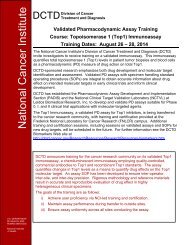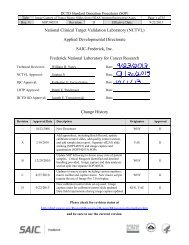National Cancer Institute - NCI Division of Cancer Treatment and ...
National Cancer Institute - NCI Division of Cancer Treatment and ...
National Cancer Institute - NCI Division of Cancer Treatment and ...
You also want an ePaper? Increase the reach of your titles
YUMPU automatically turns print PDFs into web optimized ePapers that Google loves.
Of the many successful programs within<br />
the RRP grant <strong>and</strong> contract portfolio, three<br />
scientific advances are presented, one<br />
each for physics, tumor biology, <strong>and</strong><br />
drug-radiation interaction.<br />
New Image Detector May<br />
Enable Researchers to Determine<br />
Tumor Volume<br />
Acquiring high-quality megavoltage<br />
images at extremely low radiation doses<br />
will enable more frequent <strong>and</strong> useful<br />
imaging. This is becoming a reality, thanks<br />
to a new image detector being developed<br />
through RRP-sponsored research at the<br />
University <strong>of</strong> Michigan <strong>and</strong> the Palo Alto<br />
Research Center. The new detection<br />
technology may make megavoltage<br />
computed tomography (MVCT) possible<br />
at clinically practical doses, enabling<br />
visualization <strong>of</strong> tumor volume with the<br />
patient in the treatment position, thereby<br />
minimizing errors due to patient or organ<br />
motion. Moreover, MVCT is subject to less<br />
X-ray scatter <strong>and</strong> is less sensitive to the<br />
presence <strong>of</strong> metal objects (dental fillings<br />
or hip implants) in the imaged volume<br />
than diagnostic (kilovoltage) CT, where<br />
such factors result in severe artifacts.<br />
Such benefits will enable the radiotherapy<br />
community to better achieve the central<br />
goal <strong>of</strong> radiotherapy—delivering maximum<br />
dose to the tumor while sparing<br />
normal, healthy tissue <strong>and</strong> critical organs.<br />
Sawant A, Antonuk LE, El-Mohri Y, Li Y, Su Z,<br />
Wang Y, Yamamoto J, Zhao Q, Du H, Daniel J,<br />
Street R. Segmented phosphors: MEMS-based<br />
high quantum efficiency detectors for megavoltage<br />
X-ray imaging. Med Phys 2005:32;553–65.<br />
S C I E N T I F I C A D V A N C E S<br />
Normalization <strong>of</strong> Tumor Vasculature<br />
Because cancer cells in solid tumors<br />
require access to blood vessels for growth<br />
<strong>and</strong> metastasis, inhibiting vessel formation<br />
through a process called antiangiogenesis<br />
<strong>of</strong>fers hope for reducing the mortality<br />
<strong>and</strong> morbidity from these tumors. However,<br />
when administered as single agents,<br />
antiangiogenic drugs have produced only<br />
modest objective responses in clinical<br />
trials, <strong>and</strong> overall, they have not yielded<br />
significant long-term survival benefits. In<br />
contrast, when given in combination with<br />
chemotherapy, bevacizumab, an antibody<br />
targeted against the potent angiogenic<br />
molecule vascular endothelial growth<br />
factor (VEGF), has produced an unprecedented<br />
five-month increase in survival<br />
in colorectal cancer patients.<br />
Work by Dr. Rakesh Jain <strong>of</strong> Massachusetts<br />
General Hospital, supported with <strong>NCI</strong><br />
funding managed by RRP, has led to a<br />
better underst<strong>and</strong>ing <strong>of</strong> the molecular <strong>and</strong><br />
cellular underpinnings <strong>of</strong> vascular normalization.<br />
This research suggests that certain<br />
antiangiogenic agents improve delivery <strong>of</strong><br />
drugs <strong>and</strong> oxygen to the targeted cancer<br />
cells by transiently improving blood flow<br />
to tumors. The increased drug penetration<br />
to the tumor can enhance the outcome<br />
<strong>of</strong> chemotherapy, <strong>and</strong> increased levels <strong>of</strong><br />
oxygen can enhance the efficacy <strong>of</strong> radiation<br />
therapy <strong>and</strong> many chemotherapeutic<br />
agents. This work may ultimately lead to<br />
more effective therapies, not only for cancer<br />
but also for other diseases with abnormal<br />
vasculature, as well as regenerative<br />
medicine, in which the goal is to create <strong>and</strong><br />
maintain a functionally normal vasculature.<br />
Jain RK. Normalization <strong>of</strong> tumor vasculature: an<br />
emerging concept in antiangiogenic therapy.<br />
Science 2005:307;58–62.<br />
R A D I A T I O N R E S E A R C H P R O G R A M ■ 127










